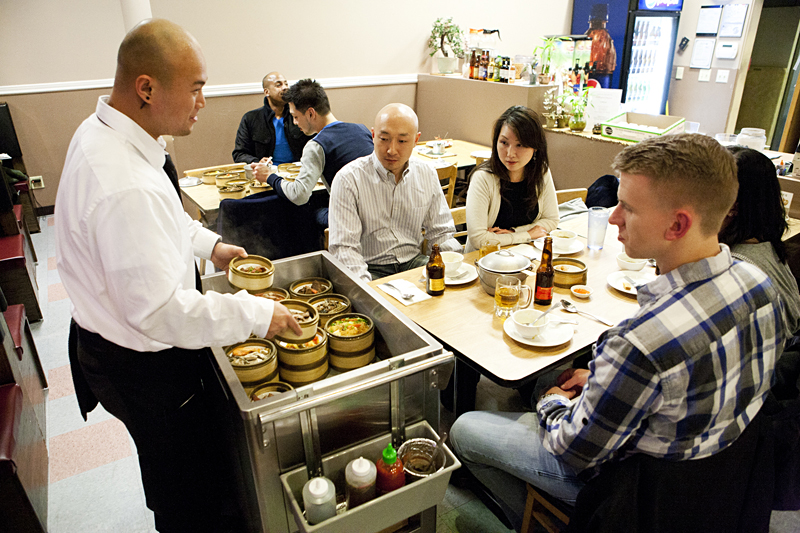When I worked as a server and had ample opportunity to observe how quickly patrons’ ravenousness tapers once seated, it occurred to me that restaurants were probably damming an impressive revenue stream with the standard menu-ordering system. Rather than make customers wait for what they want, why not auction just-prepared dishes to the highest bidder? Judging from the famished eyes which fixated on the pork chops and Cobb salads I ferried through the dining room, I figured instant gratification would be good for at least a 50-percent markup.Yet restaurants have clung to conventional service models with remarkable tenacity. You’ve got your cafeteria, your buffet, your counter-service joint, and your sit-down eatery, and if none of those styles satisfy, you can order takeout. Recent attempts to revive the automat have failed miserably, with New York City’s heavily promoted Bamn! lasting a mere two years before a banh mi impresario took over the venue in 2009. He sold his sandwiches the traditional way.Still, there are glimmers of innovation. At the year-old State Bird Provisions in San Francisco, servers wheel about dim sum carts loaded with small plates of tuna tartare, fried pig ears, and duck-liver mousse. And, closer to home, former travel agent Carlos Castrence has invented what he calls “Flip Sum.”Flip Sum is exactly like dim sum, except that it’s served both day and night, and the steam baskets lining the rolling silver carts are filled with Filipino food. There’s no precedent in the Philippines for Flip Sum—which takes its name from an historically derogatory term that’s evidently been reclaimed by young Filipinos—but Castrence says he was inspired by Filipino buffets in Rainier Valley. What he wanted most was to replicate the diversity and affordability of those buffets without dumping his stews and adobos into steam-table tanks.”It’s like a person who cannot breathe,” complains Castrence, who 30 years ago followed his parents to the U.S. He also wasn’t keen on buffet hygiene: “For example, every single person is holding the tongs. Who knows where they came from? It’s unsanitary. We wanted clean everything.”Castrence, 52, spent five years catering after leaving the travel industry, but started shopping for his own restaurant when the logistics of preparing fancy meals in home kitchens became oppressive. In 2008, he purchased Atrium Bistro, a small cafe in a strip mall near his old Northgate travel agency. He initially stuck with the cafe’s standing menu of sandwiches, content to quietly insert a few Filipino specialties, but he became more receptive to customer feedback as the recession flared.”The customers said, ‘Why are you serving Filipino-American? You’re not Filipino-American. You’re Filipino-Filipino!’ ” Castrence recalls. So last November he rechristened his restaurant Isla Manila, and debuted the Flip Sum format that had taken him eight months to devise.See Also: Photos from Isla ManilaDim sum–style service may ride its State Bird Provisions bump to increased prominence at upscale restaurants nationwide, but it’s hard to think of a cuisine more naturally suited to the treatment than Filipino. Its staples are long-cooked dishes which don’t suffer from a few trips around the room, and cautious eaters who might not order off a Tagalog menu are apt to try tiny servings of dishes they can visually assess. Isla Manila’s gregarious service staff—”Welcome to salmonella!” our server roared before asking for IDs, a gambit to learn names which he used pointedly throughout the evening—is trained to show off and describe preparations in detail. Their sales skills are important, since even in cities with significant Filipino populations such as Seattle, Filipino food is frequently misunderstood. “A lot of people don’t know what Filipino food is,” Castrence says. “It’s not like Chinese or Vietnamese. It’s just home cooking.”The Flip Sum concept is not only brilliant, but absurdly cheap. One-pot dishes and lots of pork always help keep food costs down, but even a home economist would be startled by the tab at Isla Manila, which operates on an all-you-can-eat basis. At dinnertime, eaters pay $12.99 to have as many servings as they can stand of 13 different items, freshly made that morning, plus soup, lumpia, and dessert. On Fridays and Saturdays, Castrence charges $13.99.”I can honestly say I’m the first Filipino restaurant to do all-you-can-eat,” Castrence says. “They don’t have this in California or Las Vegas.”When a restaurant is out-valuing Vegas, home of the $7.95 steak, that’s a deal worth claiming. And while bargain hunters may not particularly care about the quality of what they’re eating, restaurantgoers who are more inclined to clip recipes than coupons will be thrilled by the dishes at Isla Manila, which are uniformly satisfying.Like many strip-mall restaurants, Isla Manila doesn’t have much in the way of interior decoration: A few ornamental fans and plants share a back wall with a small flat-screen TV, and the tile-floored room is lit with fluorescent bulbs. But there’s plenty of character on the plates, starting with a meaty, gingery sinigang soup, its tamarind-inflected broth cluttered with tender long beans, shards of onion, and leafy greens cooked until they’re slack as pulled cotton.When a recipe calls for greens, Castrence often uses spinach; he’s had trouble locating fresh bitter melon leaves and refuses to use anything from the freezer case. Other adjustments to tradition include a dinuguan, or blood stew, made with boiled pig ears and stomach instead of liver and intestines, and generously supplemented with plain pork meat. But even without the usual offal, the greasepaint-dark stew has a deep, vinegary flavor.”I was surprised myself,” Castrence says. “Americans kind of like it.”There’s so much pork on Isla Manila’s carts that Castrence doesn’t pretend it’s an appropriate choice for eaters with dietary restrictions: “Filipino is not like a vegetarian kind of thing,” he says. But for swine fans, there’s a fantastic charred barbecued pork that nearly crosses the jerky line, and perfectly sour pork adobo swimming in soy sauce. Beef lovers will appreciate the hearty kaldereta, a simmered dish bright with tomato sauce and bell peppers.The prettiest of Isla Manila’s dishes may be a ginataan, or coconut-milk stew, which purchases its pop from Thai chiles. A whole grilled shrimp sits atop the diced jackfruit and white squash. While Isla Manila may not appeal to vegetarians, who probably wouldn’t warm to Castrence perpetually leaning on beef broth for flavor, there are all sorts of interesting vegetables here, including the okra pods which crisscross the pinkabet, a shrimp paste–enhanced pork stew which also features bitter melon.Castrence is fond of the added touch: He sautes and grinds shrimp for the sauce he applies to pancit bihon, the slippery fried rice noodles that appear at every Filipino party. “What I have in mind,” Castrence says, ” is I want to be different than anybody else.”hraskin@seattleweekly.comPRICE GUIDELunch $10.99Dinner $12.99
When I worked as a server and had ample opportunity to observe








